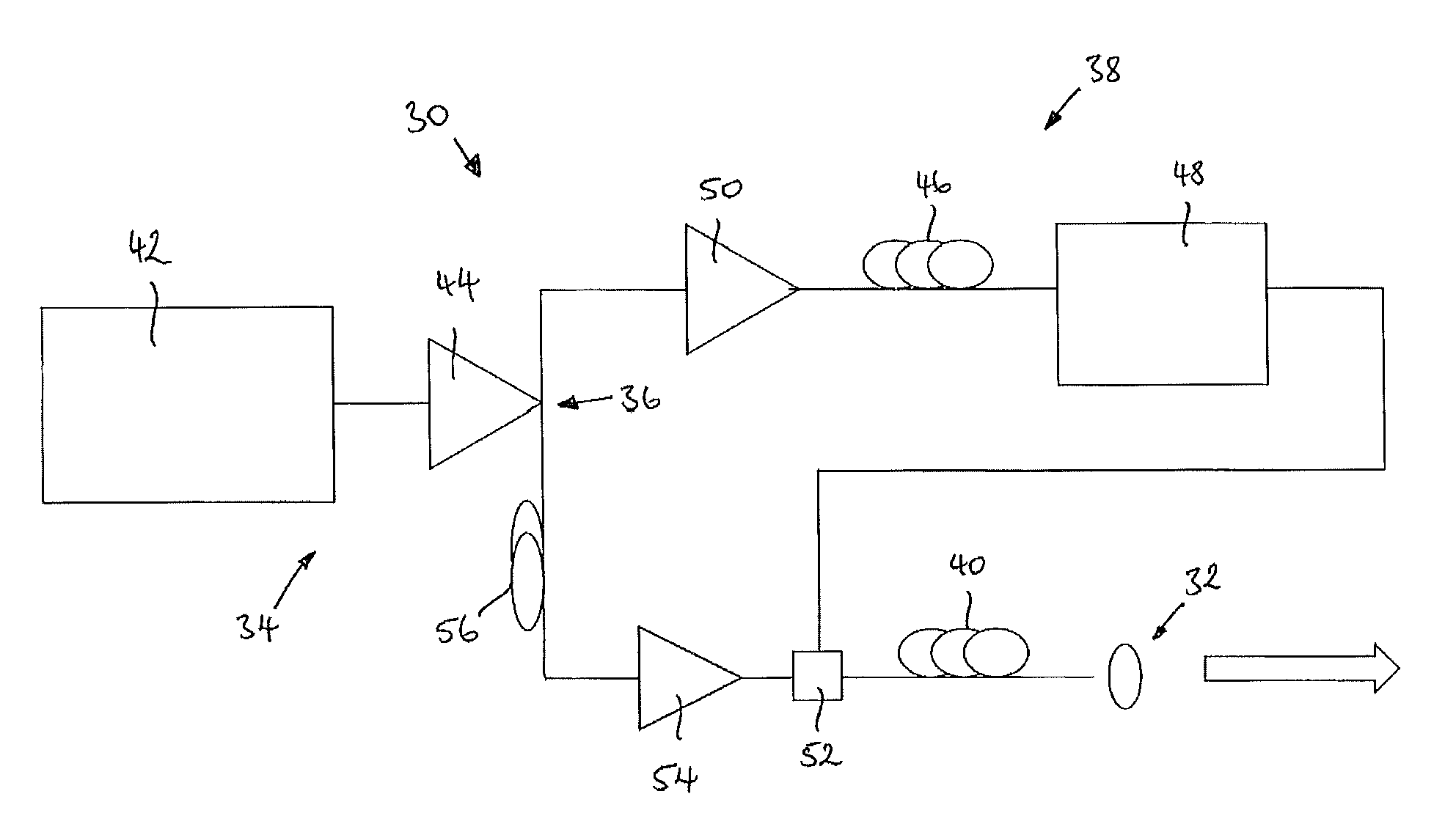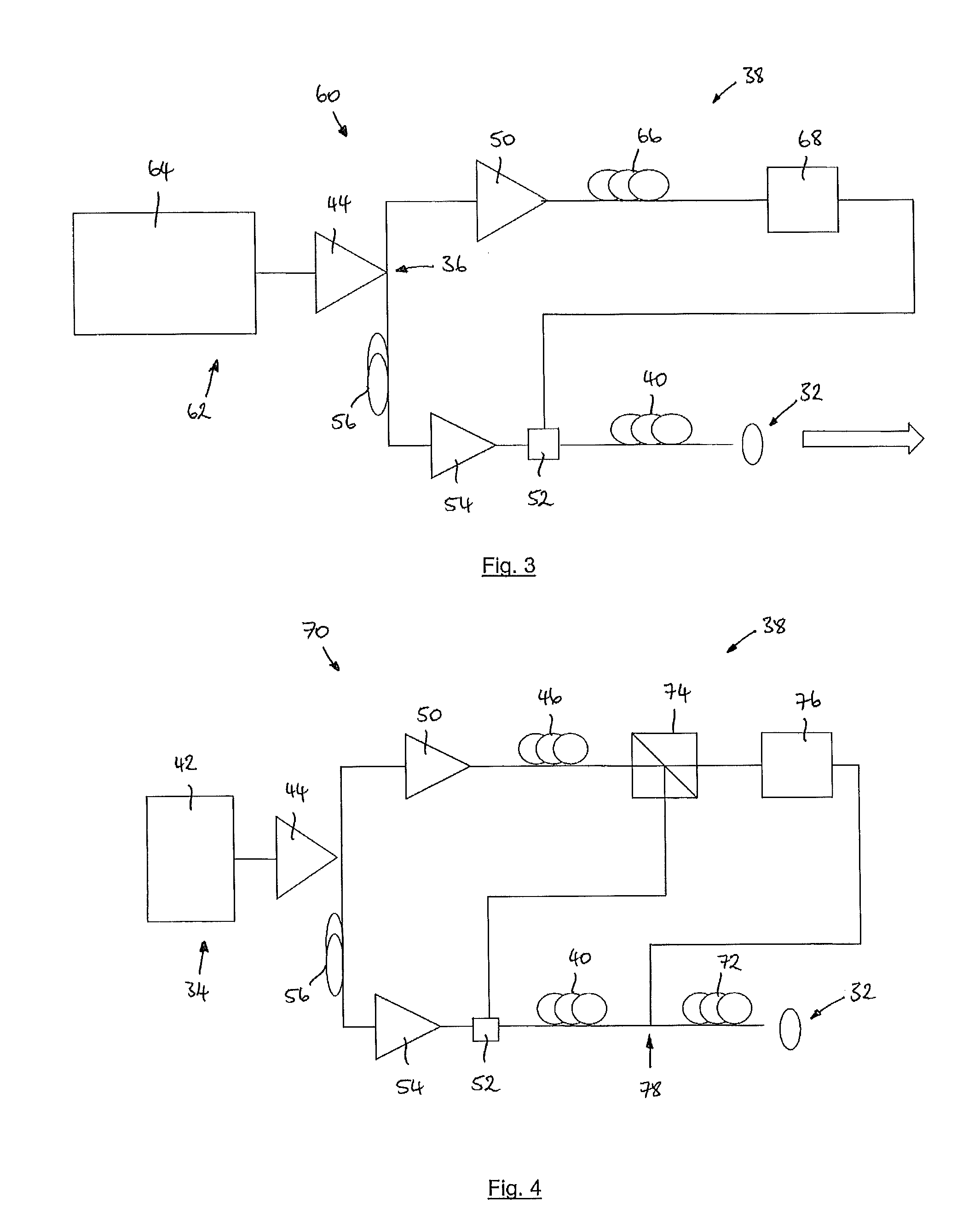Optical Sources
a technology of optical sources and pulses, applied in the field of optical sources, can solve the problems of adding complexity to the system, unable to provide optical pulses of sufficient power and frequency at the desired wavelength, or existing pulsed optical sources are optically very complex, and therefore expensive, so as to achieve tight focussing and integration, enhanced wavelength range and wavelength selection
- Summary
- Abstract
- Description
- Claims
- Application Information
AI Technical Summary
Benefits of technology
Problems solved by technology
Method used
Image
Examples
first embodiment
[0138]Referring to FIG. 1, the invention provides an optical source 10 comprising an optical output 12 arranged to output an output optical signal, a pump optical source 14, an optical splitter 16, seed signal forming apparatus 18 and a first microstructured optical fibre (MSF) 20.
[0139]The pump optical source 14 is arranged to generate an optical signal at a pump wavelength. The optical splitter 16 is arranged to receive the optical signal and to split the optical signal into a pump signal and a seed pump signal. The optical signal can comprise a pulsed or continuous wave (CW) optical signal, such that the optical source 10 can comprise a pulsed or CW optical source.
[0140]The seed signal forming apparatus 18 is arranged to receive the seed pump signal at the pump wavelength. The seed signal forming apparatus 18 is further arranged to transform the seed pump signal into a seed signal at a seed wavelength. The seed signal forming apparatus 18 comprises an optical element arranged to ...
second embodiment
[0144]An optical source 30 according to the invention is shown in FIG. 2. The optical source 30 comprises an optical output 32 arranged to output an output optical signal, a pump optical source 34, an optical splitter 36, seed signal forming apparatus 38 and a first microstructured optical fibre (MSF1) 40.
[0145]The pump optical source 34 comprises a pulsed laser 42 arranged to generate an optical signal comprising optical pulses. The optical pulses have a pump wavelength of, in this example 1064 nm, a 20 MHz pulse frequency and a pulse duration of approximately 80 ps. The pump optical source 34 further comprises an optical amplifier 44 arranged to receive the optical pulses from the laser 42 and to amplify the pulses to have an average power in the region of 100 mW
[0146]The seed signal forming apparatus 38 comprises a first optical fibre 46 and an optical filter 48. A second optical amplifier 50 is provided between the optical splitter 36 and the seed signal forming apparatus 38, an...
third embodiment
[0151]the invention provides an optical source 60, as shown in FIG. 3. The optical source 60 is substantially the same as the optical source 30 of the previous embodiment, with the following modifications. The same reference numbers are retained for corresponding features.
[0152]In this example, the pump optical source 62 comprises a wavelength tuneable pulse laser 64 operable to generate optical pulses at a pump wavelength tuneable between 1055 nm and 1080 nm. The optical pulses have a pulse frequency of 20 MHz, a pulse duration of 80 ps. The optical amplifier 44 is arranged to receive the pulses from the laser 64 and to amplify them to an average optical power of approximately 100 mW.
[0153]In this embodiment, the seed signal forming apparatus comprises a second microstructured optical fibre (MSF2) 66 of the same type and length as MSF140. MSF2 is arranged to receive the seed pump pulse and to cause the seed pump pulse to undergo four-wave mixing on transmission through the fibre 66...
PUM
| Property | Measurement | Unit |
|---|---|---|
| wavelength | aaaaa | aaaaa |
| wavelength | aaaaa | aaaaa |
| wavelength | aaaaa | aaaaa |
Abstract
Description
Claims
Application Information
 Login to View More
Login to View More - R&D
- Intellectual Property
- Life Sciences
- Materials
- Tech Scout
- Unparalleled Data Quality
- Higher Quality Content
- 60% Fewer Hallucinations
Browse by: Latest US Patents, China's latest patents, Technical Efficacy Thesaurus, Application Domain, Technology Topic, Popular Technical Reports.
© 2025 PatSnap. All rights reserved.Legal|Privacy policy|Modern Slavery Act Transparency Statement|Sitemap|About US| Contact US: help@patsnap.com



